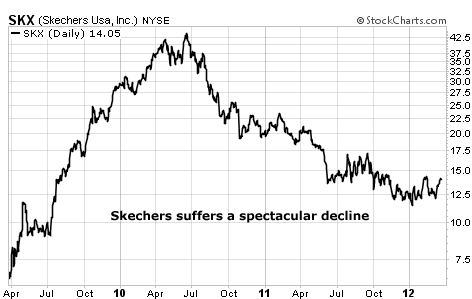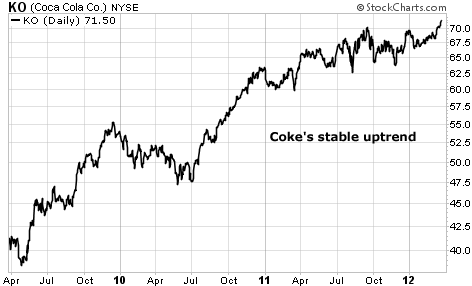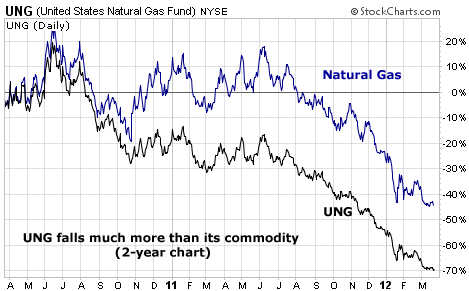| Home | About Us | Resources | Archive | Free Reports | Market Window |
The One Question That Leads to Long-Term Wealth in StocksBy
Saturday, March 24, 2012
Most everything you need to know about building long-term wealth in the stock market you can learn with one simple story.
If you understand the lesson of this tale, you stand a good chance of growing a substantial fortune in the stock market.
If you ignore the lesson, you're virtually guaranteed to be a stock market loser...
The story is about soda... and shoes. It played out from early 2009 to early 2012. It involved the soft drink maker Coca-Cola (NYSE: KO)... and the shoemaker Skechers (NYSE: SKX).
You see... in the stock market, there is an "elite" class of stocks. These companies typically have world-famous, respected brand names – like Coca-Cola. They also typically have basic, stable businesses – like selling soda, chewing gum, razor blades, or fast food.
Because these companies enjoy elite brand-name status and have a stable business model, their profit margins are consistent and fat. Thus, they are able to pay a reliable portion of their profits out to shareholders in the form of cash dividends. Often, these dividends represent a 3%-5% annual yield on their share prices. In other words, shareholders of these companies get paid every year.
Of course, you rarely hear one of these companies registering a "spectacular" 50% surge in sales. With these guys, it's "stable" not "spectacular."
The thing is... "stable" is too boring for most investors. Brokers and investment salesmen have a heck of a time selling people on this "stable" idea.
That brings me to another class of stocks out there... "exciting" stocks. These companies often have a hot new product... or a fantastic "story." They are capable of reporting a 50% surge in sales – the kind of surge a large, stable firm will almost never report.
These are the companies most investors like to buy.
In 2009, if you had given 100 average people the opportunity to invest in Coca-Cola or Skechers, at least 90 of them would have chosen Skechers.
Back in 2009, Skechers was enjoying a big marketing "buzz" related to its new "Shape Ups" shoe line. "Shape Ups" are sneakers with an unbalanced sole. Because of this unusual sole, it takes more effort to walk around in them. Skechers was able to make the claim that people could get "toned" just by walking around in its shoes.
Skechers got famous athletes and Hollywood babes to endorse the product. "Shape Ups" were profiled in major newspapers, magazines, and television shows. America went wild for the shoes. It was a "hot" product. The sales and marketing success helped Skechers boast quarterly sales increases of more than 40%.
Because of the "Shape Ups" buzz and sales growth, Skechers shares climbed more than 300% from mid-2009 to mid-2010. Skechers' shoes and stock became a sensation.
During this "spectacular" period for Skechers, Coca-Cola kept doing what it had been doing for decades. It sold soda all over the world. It rang up steady sales. It paid its cash dividend (and even raised it a little). Its shares climbed, but nowhere nearly as fast as Skechers shares climbed.
In mid-2010, Skechers was one of the market's most popular stocks. Its year-to-date gain by June was 50%. But then, something awful happened.
Cheaper competitors entered the market. Plus, new studies disputed Skechers' claim that its shoes produced results. The "Shape Up" fad started to bust... Skechers fourth-quarter 2010 earnings declined 89% versus the previous year's same quarter.
From June to December, shares lost 55%. It was a "spectacular" decline. Shares lost another 40% over the next year.
 Meanwhile, boring, "stable" Coca-Cola kept selling soda... It kept paying dividends... And its share price kept inching higher.
 By now, you can probably guess the investment lesson... one most people go their whole lives without learning...
If you're interested in making a meaningful, long-term stock investment, elite "stable" companies like Coca-Cola, McDonald's, Intel, and Johnson & Johnson are the Holy Grail.
The average "spectacular" company, a company that captures the public's imagination with a fad product, is almost sure to destroy most investors. Skilled short-term traders can make money in these stocks, but they're not suitable for long-term investments.
The elite, stable company is resistant to competition. It's extremely unlikely that a small startup company will cut into Coca-Cola's sales. Same goes for Intel or Johnson & Johnson. We can't say that about a company with a "hot" fad product. Plus, the company with the fad product doesn't have a stable enough business model to pay shareholders a cash dividend.
Another way to think of this is with a house analogy. Owning robust dividend-payers is like living in a sturdy brick house, resistant to all types of weather. With this house, you're free of worry. Owning an exciting "fad" company is like living in a grass hut. You're in constant danger of bad weather wiping you out.
Despite the obvious benefits of choosing "stable" over "spectacular," most investors make the wrong choice. Most folks aren't wired to think long-term. They're obsessed with short-term gratification. So they chase fads and "hot" ideas... instead of buying the stocks that can make them long-term rich.
When you're considering placing serious, long-term money in a stock, remember this story... And ask yourself this one question...
Does this company sell a product or service that folks will still want in five or 10 years... or is it a hyped-up fad?"
If the answer isn't clear, don't buy the stock.
Regards,
Brian Hunt
Further Reading:
Dan Ferris says investing in these "elite companies" is the surest, easiest, greatest way to get rich in stocks. Learn more here...
If you're done fretting whenever the market takes a hit... if you want to sleep well at night no matter what the market does... if you want to see your income rise every year... relentless dividend-raisers like Wal-Mart are the kind of stocks you need to own.
If you understand and take this lesson to heart, you'll be ahead of 99% of your fellow investors.
Market NotesCHART OF THE WEEK: A SUPER TAX-LOSS GENERATOR In observance of tax time, we devote our chart of the week to an asset that helps ring up losses, which can be deducted from personal income.
Our chart of the week welcomes a familiar "whipping boy," the popular natural gas fund, symbol UNG.
Because they provide investors with a "one click" way to own baskets of stocks or commodities, investment funds like UNG have enjoyed a surge in popularity. However, some commodity funds are structured so they must continuously enter the futures market in order to maintain positions. This process often makes the funds "bleed" value... which results in large shareholder losses.
You can see this dynamic at work below. Our chart plots the performance of natural gas (blue line) and UNG (black line). As you can see, natural gas is down big, about 45%. But UNG's structure allows it to ring up a 70% loss. Looking for deductions to personal income? Look at UNG!
 |
Stat of the week
46%
Gain in the major homebuilder stock fund since mid-October.
In The Daily Crux
Recent Articles
|

